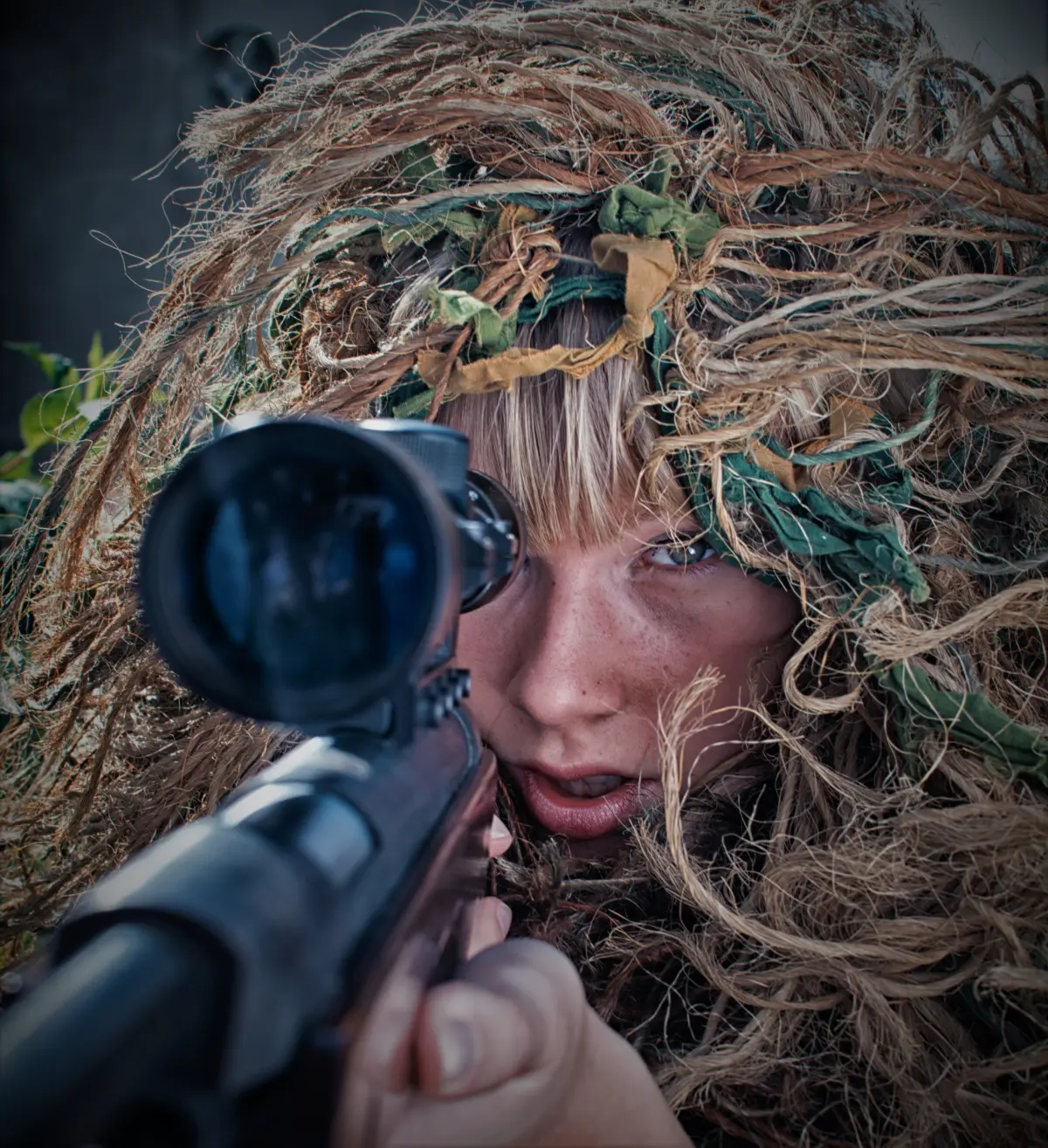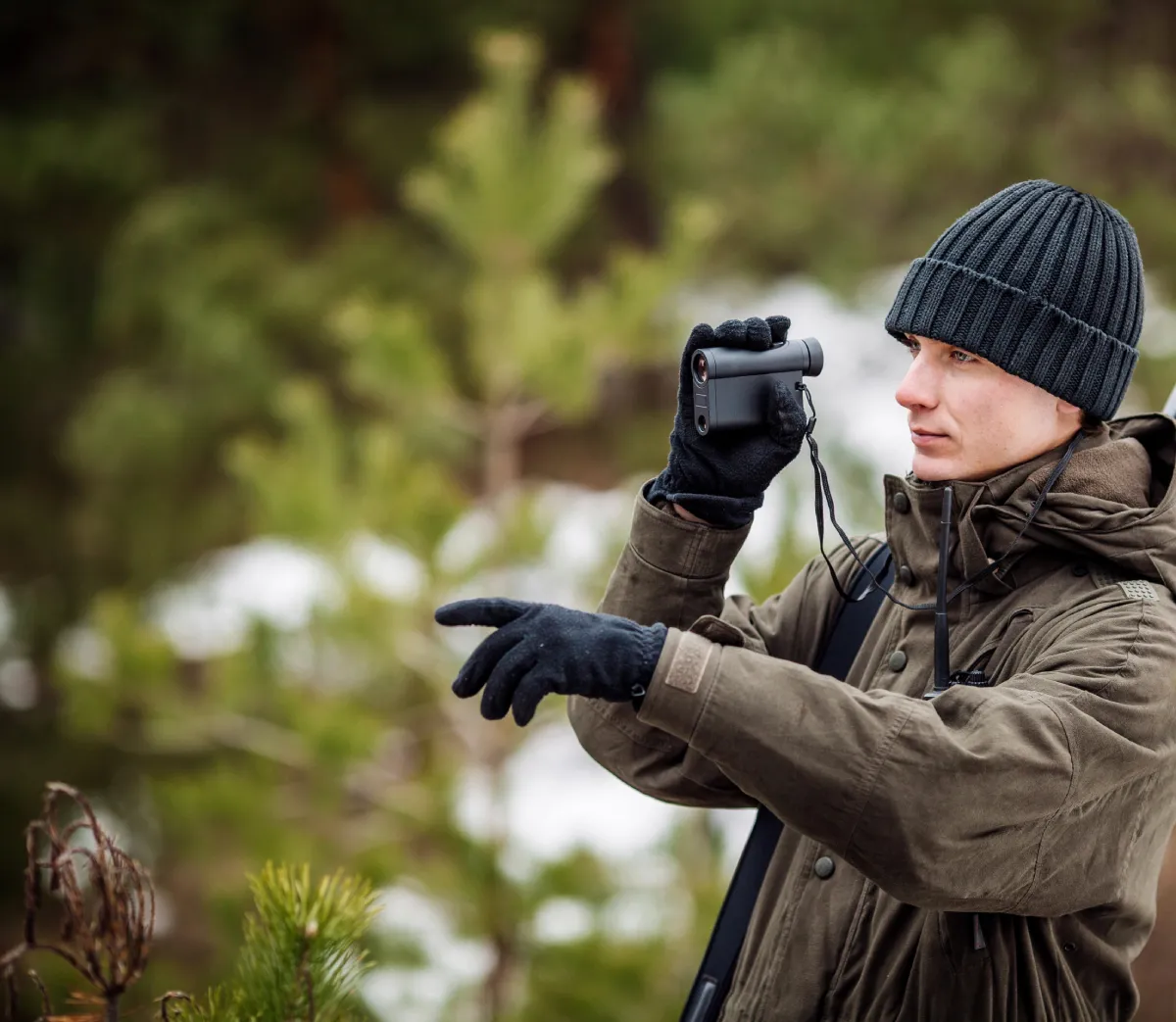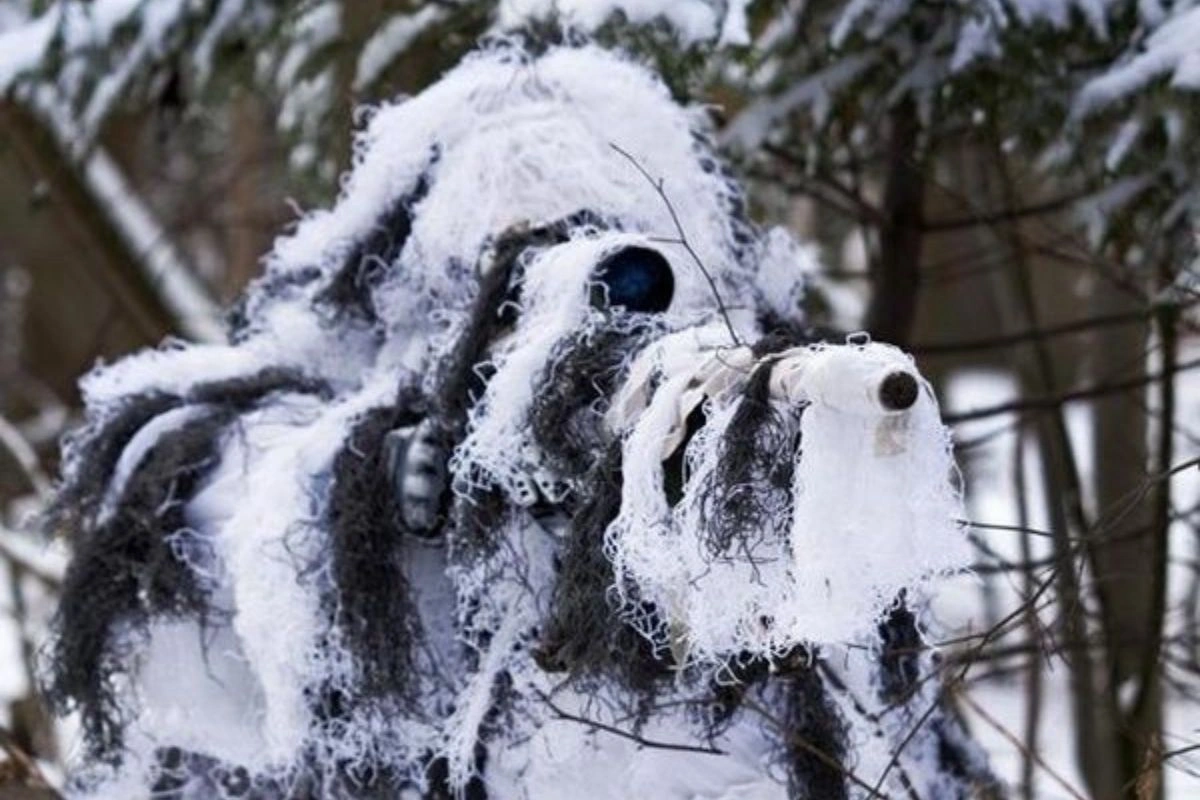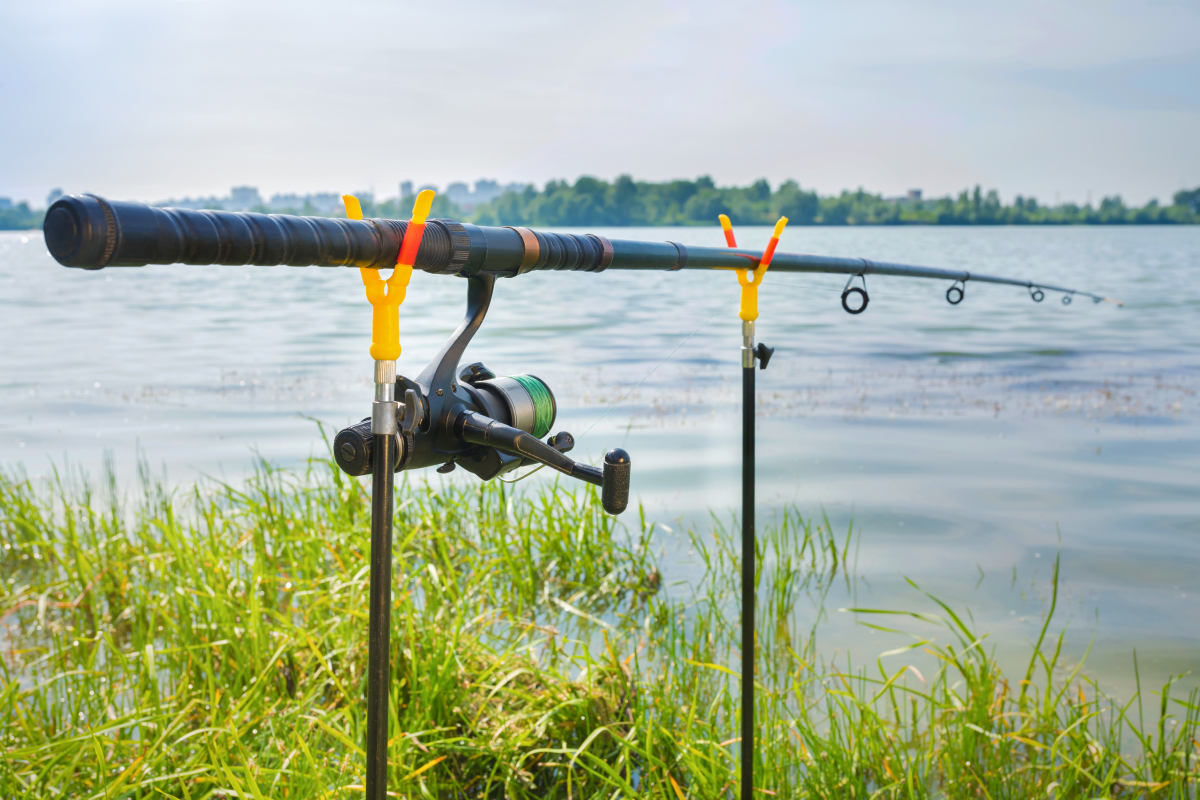Ghillie Suit Basics
To learn how-to pick a ghillie suit you need to first understand some terms. Such as camouflage and resolving power of the human eye.
What Is Camouflage?
The Merriam-Webster Dictionary states that camouflage is “concealment using disguise.” Concealment means “to hide or place out of sight.” Camouflage doesn’t create full concealment, but rather creates a blend of contours. Blending breaks up straight lines to allow the camouflage to look random like nature. Proper camouflage needs the use of natural materials like twigs, leaves, and grass.
Consider that there are no forms in nature with perfect straight lines. Add to this, the human form in nature is one of the most recognizable shapes. To help disguise the human form people will camouflage themselves in a ghillie suit.
Understanding Resolving Power of the Human Eye
It’s important to understand the concept called the “resolving power of the human eye.” Resolving power is the ability of the eye to differentiate between two points at a distance. What this means is the further you are from something, the more difficult it is to see.
As a human, you have the obvious physical limitation of having two unaided eyes. But remember wildlife has advanced vision compared to humans. Animals notice movements that most people don’t notice. This helps to explain the success of using camouflage from wildlife or opposing armies via a ghillie suit.
Definition Of A Ghillie:
The word “ghillie” is an early 19th-century Scottish term for a special kind of “ gamekeeper” or hunter. A ghillie hunter’s job was to protect the “game animals” on their Lord’s land. One tactic that a ghillie used was to add foliage to their clothing.
Using this foliage they would lay motionless on the ground to stalk their game. As an unsuspecting game ambled past the ghillie would jump and tackle them. This ghillie warden would proceed to haul the game up to the Lord’s keep to allow them to “mock hunt” it in the courtyard.
What Is A Ghillie Suit?
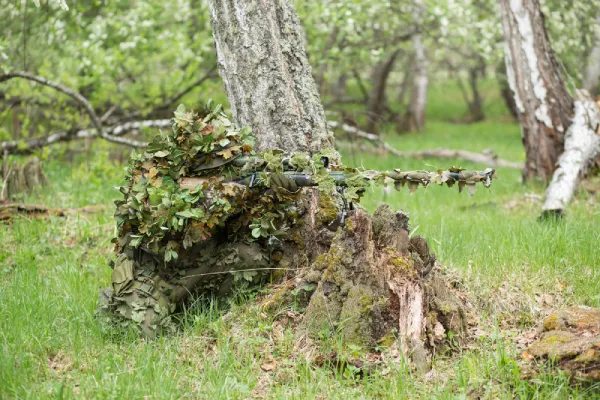
A ghillie suit is a camouflage garment you wear to help to disappear into your surroundings. Worn over your clothes this suit made of colored strands creates a blending of contours. Blending breaks up straight lines to make your body’s outline appear random like nature.
Ghillie suits are best used for stalking a target from a fixed position. Such as snipers, hunting at a distance or trying to view wildlife while hidden.
History Of The Ghillie Suit
The first creation of what we call a ghillie happened during the “Second Boer War.” Scottish army soldiers in Britain’s military introduced Ghillie warden tactics. The soldiers used anything they could find to break up the human silhouette. Including grass, and branches among other items to create a leafy suit that hid them from sight. As such, they gained a considerable advantage on the battlefield. Including sneaking behind the enemy lines to gather valuable information.
What began as a military uniform transformed into camouflage for many types of users. From a tactical police swat sniper to enthusiast hunters. In newer mock shooting activities like air-soft and paintball players use a ghillie to get a “leg up” on the competition.
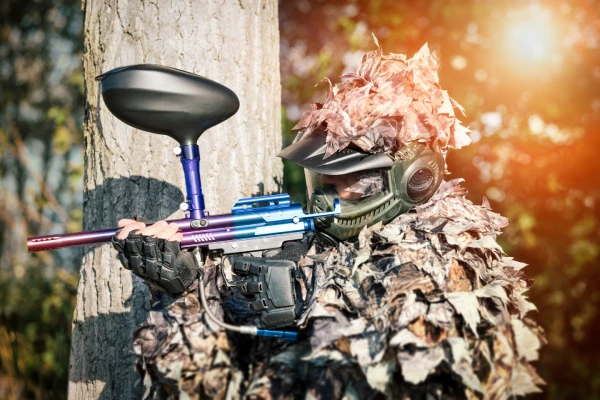
What Is a Winter Ghillie Suit?
A winter ghillie suit is a camouflage garment to aid in concealing a person in a snowy area. This type was first used in 1917 by the military for alpine battles. Winter ghillie suits use special white patterned strands to blend contours. This ghillie can be heavier than the woodland ghillie suits because you move less. Think of wearing it like a snowy blanket to break up your distinctive human shape. A high-quality winter ghillie will also have more insulation.
Alternative Ghillie Suit: A BDU
A BDU or Battle Dress Uniform consists of an army-issue camo shirt and pants. It has two uses, one to provide a basic level of concealment, and two as a base to build further camo.
The main advantage of a BDU is that they’re a lot tougher and easier to wear than thin mesh leaf suits. Plus you have plenty of pockets to stow extra shooting kit inside. A BDU is also helpful in a muggy jungle terrain or when to make swift position changes.
One disadvantage of a BDU is that they are form-fitting, meaning your ability to camo yourself is lower. Another downside, is they’re not as breathable as an actual ghillie suit. This option is great for airsoft or paintball players where moving around is common. When buying a BDU, look for pants with built-in soft knee pockets (stay away from plastic knee pads, they’re noisy). As well look for products with elbow pockets for padding while crawling.
Handmade Ghillie Suits
Making a ghillie suit from scratch is a time-consuming process. A high-detailed ghillie can take weeks or months to make and season. The following is an example of a traditional method to make ghillie by hand.
In general, its base is a rough webbing made of durable, stain-able fabric like soft mesh or burlap. Makers will use special dyes to color the ghillie fibers to impersonate the local environment. Today, many suppliers sell pre-dyed jute threads.
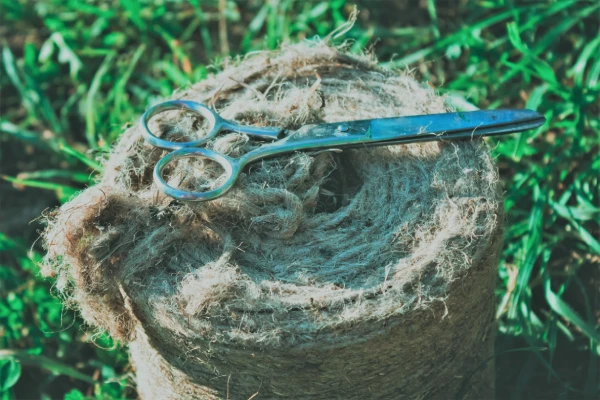
Users who buy pre-dyed threads need to pick colors that match the local terrain and its shadows. Or makers can dye natural jute threads themselves. This allows for more shades and customization but adds time to the process. Bear in mind, that jute fibers are flammable! It’s best to apply fire retardant on the fibers before threading them onto the base layer.
On top of the base, the outer layer starts to take “shape.” First, a knot of netting gets sewn to the base fabric. The netting is a nearly invisible material like fishing line. Next, you tie 5-10 strands of color with simple knots into groups. Each time a group gets attached you skip the next section to create a gap. These gaps get filled with another color.
Next you “season” the ghillie webbing by dragging it behind a vehicle. Make sure to drag it through wet mud, or apply manure to give it a natural “earthy” scent. Traditional leafy suits get customized on location with local woodland flora. The disadvantage of local additions is that they wilt over time and you have to change them.
Long build timelines and constant changes make off-the-rack ghillies more attractive to buyers.
Buying Considerations: How-To Pick A Ghillie Suit
Pick A Level Of Effective Concealment
Think about how much of your body you need to conceal. The first element to learn for how-to pick a ghillie suit is the amount of concealment it provides. Ghillie suits provide superior concealment to “flat” cloth camouflage. Because they add a sense of depth to the otherwise two-dimensional human outline.
To understand what this means, first imagine looking at a telephone pole that is 100 yards (91.44 m) from you. It looks flat, right? This is because your eyes aren’t far enough apart to determine the pole’s third dimension. Next, look at the shadow that is cast by that pole, and pay attention to the color of the shade. There’s no printed cloth available that can duplicate the darkness of this shadow.
Second, look at a bush the same 100 yards (91.44 m) distance from you. Do you notice the sense of depth and shadowing? It makes the bush appear to have three dimensions. This shows that having strands of twigs, leaves and other 3-D elements helps hide your outline.
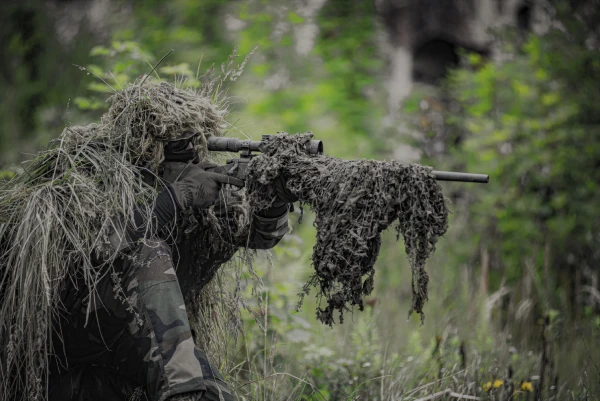
Another item to consider for effective camouflage is if you hunt with a firearm. Look for a ghillie suit that comes with a gun bag or wrap. A gun wrap is like a personal ghillie for breaking up the gun barrel’s straight lines.
Where effective concealment is vital, is for law enforcement as it lets them put full focus on the task at hand. Having proper concealment is crucial at times, as their lives depend on it.
Consider Ghillie Style & Size
Did you know that ghillie suits come in two distinctive styles? One style of ghillie fits like a poncho or large blanket with arm holes. While a second style has a jacket with a hood and pants combo. Which style you decide to choose, depends on the activity you are doing.
The long poncho style is best for users who stay motionless such as a sniper. Whereas multi-piece ghillie suits are best for users who need to move but want to keep hidden. Such as hunters, airsoft or paintball players.
Keep in mind that ghillie suit size is important as well. The bigger the ghillie the easier it is to blend into the terrain. The downside to a big ghillie is that it is cumbersome to move around in. Find one that delivers effective camouflage but is also comfortable to wear.
Factor In High-Quality Construction
The second element for how-to pick a ghillie suit is the physical construction. This element is vital for effective concealment. Because without high-quality construction you will waste your money. Poor construction leads to gaps in fibers, exposed burlap and bad concealment.
Good ghillies should hide the user and allow them to make small movements with little noise. You need to choose one with outer layers that look as natural as possible. The thread pattern or strands should cross-lay to make a 3-D blend. Keep in mind, that the coloring should match the local vegetation that you hunt in most of the time.
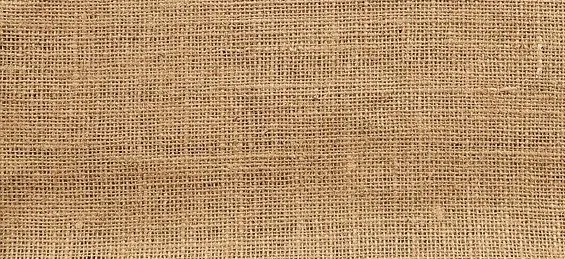
Burlap is the traditional material for the base layer of a ghillie suit, but today you should look for a mesh. Mesh is better at keeping you cool and preventing insect intrusion. For the exterior material, look at the texture, does it look flat or block-cut? A ghillie with these characteristics won’t fit into the natural vegetation. Because nature doesn’t have plastic looking elements or clean-cut edges.
Materials Matter
Third, for how-to pick a ghillie suit you need to factor in the material. Manufacturers construct ghillies using either natural jute threads. Or common synthetic materials like polyester and nylon. Natural materials like cotton are bad, as they absorb moisture and take forever to dry. Unnatural materials like polyester will give the outfit a high resistance to moisture and mold. Another bonus is they can dry at a rapid rate to help you keep comfortable in the harshest of conditions.
Imagine being a hunter or sniper who is out in the field for an extended period. The weather is inclement, delivering mixed rain and snow. Having a ghillie that blends you into the local foliage and keeps you dry ensures extreme focus.
If you play airsoft or paintball you will prefer a lightweight polyester ghillie suit. This allows for swift movements and the ability to blend into your surroundings.
Whichever activity you are doing, look for a ghillie suit with 3/4″ inner mesh netting. This material promotes cooling but prevents insect intrusion. Materials that breathe also reduce overheating. Temperatures inside a ghillie suit during any activity can reach over 50 Celsius (120 F). These temperatures are both uncomfortable and dangerous.
It Must Be Tough
You need to look for features to ensure the ghillie will withstand the environment it’s used in. The following are some durability questions that are vital in how-to pick a ghillie suit:
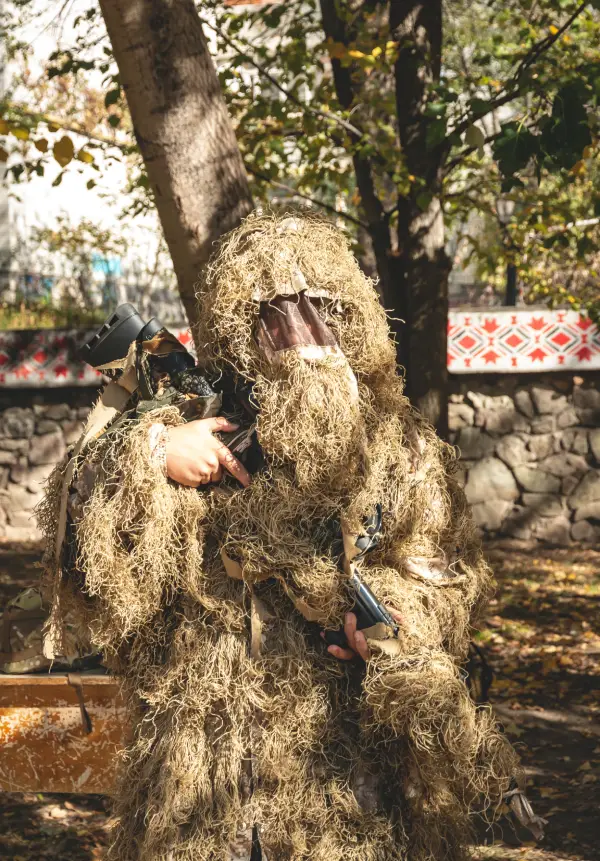
Is it made with rot-resistant materials and durable stitching? Nothing is worse than investing in an outfit that falls apart after a couple of uses. Pay attention to the quality of the inner and outer parts of the suit.
What about being fire-retardant? This is vital because you wear and use your ghillie around ignition sources. It’s important to know that basic burlap isn’t fire-resistant, nor is natural jute thread. For buyers of hunting, airsoft or paintball ghillies most off-the-rack suits use a mix of polyester and nylon fabrics. Which is convenient because polyester is inherently a flame-retardant material.
Does it feature water-repellent properties? Every single water drop (like morning dew or mists) that hits the suit adds weight. Heavy ghillies make tripping due to fatigue a risk.
Do the added features cover the basics? Look for the little things, like quiet closures on the jacket or snag-free strands. Also, consider that it’s loose-fitting to accommodate tactical vests or inner jackets. Don’t overlook that good brands should provide a warranty to fix any issues too.
Ghillie Color Is Crucial
This should be obvious, pay special attention to the colors that make up a ghillie suit. You need to pick a color pattern of a mix of natural tones that blend into one another. If you don’t make the right choice, you won’t be able to make an accurate mimicking of the background terrain.
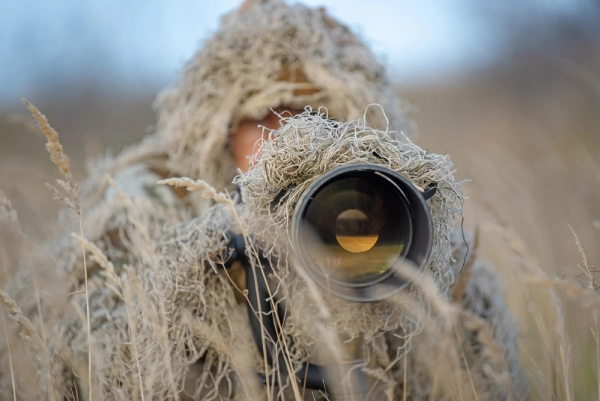
A wide variety of color schemes and toning emphasis are available. Each should match as wide a variety of shades and vegetation that exist in your given terrain.
Pay Attention To The Weight Of A Ghille
Your use and type of terrain will determine the weight of a ghillie suit. The weight of your suit plays an important part in your efficiency and comfort for hunting. A good ghillie suit is cool and comfortable and discourages insect penetration.
Most of the hunting/air-soft ghillie suits sold will weigh around five pounds or fewer. While this weight doesn’t sound like much, walking around wearing it can be tiring after a while. Bear in mind, that hunters walk for long distances stalking prey. As every hour passes, every extra pound becomes noticeable. Whereas airsoft or other snipers lay hidden waiting to hit their target, so weight isn’t an issue.
Brands Matter
The manufacturer’s experience is extensive. These days, because of the popularity of ghillie suits among mainstream buyers. Several brands make these special camouflage outfits. But some brands skimp on crucial features, so be careful what you choose.
Select historic ghillie makers or a brand that only makes ghillies. If picking the latter, find a brand offering a wide selection of styles so you can get the one best for your needs. If you shop online, look for listings that include the following:
1. Ghillie Materials
2. Weight & Dimensions
3. Color Pattern
4. What’s Included
5. Jacket & Trouser Closure Types
6. Any Accessories Included.
A quality ghillie takes on personal attributes, like a trusted gun. In the end, it should enhance your success rate.
Does The Ghillie Come With Accessories?
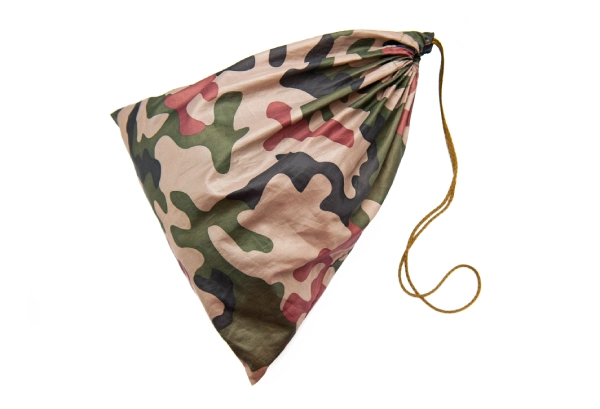
The better ghillie offerings will come with accessories to aid in camouflaging. The more included accessories provided will deliver a better level of concealment.
Military-grade options may include chest/knee pads, crawl covers and more. While ghillies for hunting, airsoft, or paintball should at least have a gun wrap and stuff sack.
A gun wrap is a matching cover for your rifle and scope. A stuff sack is for packing up your ghillie at the end of the day.
Don’t Cheap Out!
It’s unexpected for some people about the amount there is to think about in selecting a ghillie. But if you follow this guide you can buy a good quality ghillie suit for a competitive price.
My biggest recommendation is to stay far from super cheap ghillie suits. Because it won’t provide the required level of concealment and can wear out fast. In fact, some of the cheapest ghillies are no more effective than a basic Halloween costume.
Finishing Up: How To Pick A Ghillie Suit
In the end, you have all the information for how-to pick a ghillie suit. Keep in mind that the best choices will depend on many personal factors. Consider what type of camouflaging you need, and if you need to move around a lot. Next pick which material type, weight, size, color, ease of use and accessories. By completing this how-to guide you will buy the right ghillie suit for you in 2024.
Thanks for letting Outdoors Informed aid you in your research. Until next time!
